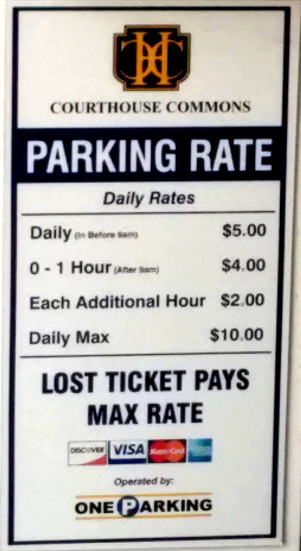Sometimes Metered Pricing Isn't Good Enough
Monday, September 17, 2018
People who aren't students of economics seem to love one pricing method above all others: metered pricing. Under that system, prices are based upon usage. The more of a product that a customer consumes, the more he is required to pay.
The popularity of metered pricing shouldn't be surprising. It has a lot going for it:
- It's easy to implement - Vendors can just measure what a customer uses and charge accordingly.
- It's easy to explain - Customers understand the concept of being charged for what they use.
- It seems fair - Vendors earn more when customers use their products more.
- It aligns incentives - Vendors are encouraged to improve buyer satisfaction, because satisfied customers are more likely to make repeated purchases.
Many businesses, however, have found that metered pricing just isn't good enough. Let's take a look at one such business: a parking garage in my home state of Florida.

The middle of the pricing sheet shows that the garage has implemented metered pricing. The longer customers keep their cars inside, the more they'll have to pay.
There's a slight twist in that the company has increased the cost of the first hour relative to the "standard" hourly rate. Some businesses add service fees, connection fees, or other surcharges to create a pricing floor while maintaining the appearance of consistent unit pricing. Nevertheless, the underlying system is clear: the more of the garage's time customers use, the more they'll have to pay.
That's not the only twist. At the bottom of the price sheet, there's a clear notice that the maximum a customer will be required to pay is $10 per day. This is far less than the maximum charge for a day's worth of use "should" be according to the metered pricing schedule. Is the company providing this discount in the spirit of generosity? Hardly.
As the cost of parking grows, consumers will be increasingly incentivized to seek out substitutes for parking at the garage.
For example:
- Parking lots with lower rates
- Uber, public transportation, bicycles and other forms of transportation that do not require access to parking garages
- Going elsewhere
The top of the sheet presents yet another variation to the standard metered pricing model. Customers who park before 9 a.m. are billed at the "daily" rate which is both low and unmetered.
Is there something about parking lots that makes them cheaper to operate when customers enter early in the morning? Do the cars that are parked earlier somehow require less space?
The answer to both questions is an emphatic no.
The reason for the discounted daily rate is that it mainly applies to a single customer segment. The cars being parked earlier in the day might not be different than the rest, but their drivers are. They're mainly people who work in the area and need a place to park on a regular basis. While an occasional visitor to the city might not mind paying $10 per visit, customers who need to park on a daily basis will find that such bills add up quickly. Many of the workers have neither the ability nor willingness to pay so much on a regular and on-going basis.
As a result, the owners of the parking lot faced a very important dilemma:
- If they charged what the tourists would be willing to pay, regulars would avoid the garage.
- On the other hand, if metered pricing were set at levels that would be acceptable to people who worked in the city, the garage would leave money on the table. The tourists would wind up parting with only a fraction of what they would be willing to pay.
That's where the "in before 9 a.m." rule shines. It allows the garage's owners to segment the market and push each group to spend an amount closer to its upper limits.
While there is no law that states that people on vacation can't wake up early to park in a city, tourists don't tend to rush things in the morning. They get up late because they can - after all, they're on vacation. In fact, they share a very real incentive to wait until after 9 a.m. to park. Driving to the garage early in the morning would require them to fight rush hour traffic, a nerve-racking experience that requires significant time spent behind the wheel.
Cynics might argue that the early bird rate provides a secondary bonus as well. The large print advertising the "daily" rate entices drivers to enter the parking garage. It is only when they are inside and unable to turn around that they are able to read the fine print explaining the "in by 9 a.m." requirement.
In any case, the garage's decision to hybridize its pricing scheme likely provides it with a sizable increase in profits. It also illustrates a very important point. A business that relies purely upon metered pricing, with all customers paying the same rate, is almost certainly earning less than it could.